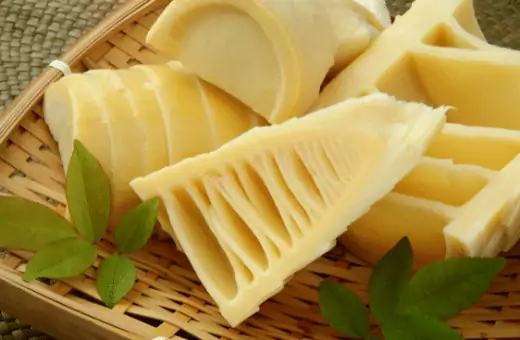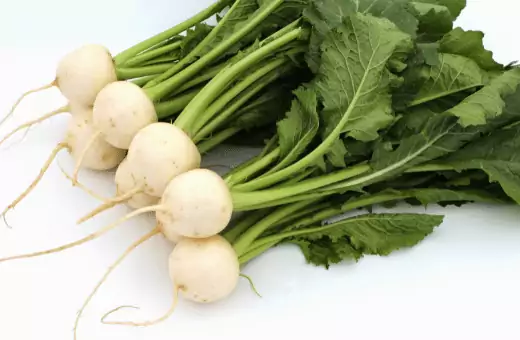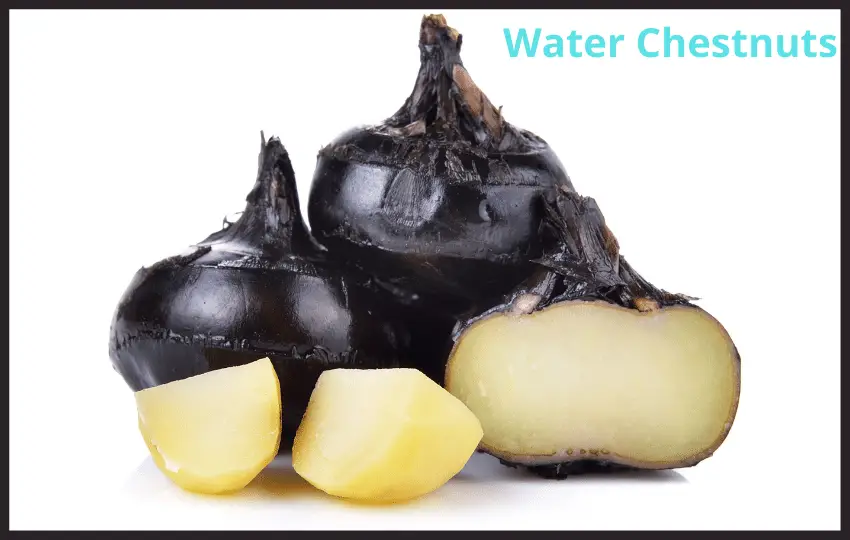Is there a substitute for water chestnuts? If so, then what’s a good substitute for water chestnut? So many questions pop up while you are a home chef and need to replace water chestnut in your recipe.
However, the good news is that there are a plethora of other options that will work with the same flavor. -These include Bamboo shoots, Jerusalem Artichoke, Jicama, Daikon, or even Celery.
In addition to water chestnut alternatives, keep in mind that these ingredients can offer a variety of tastes and textures, so study the ingredient lists carefully while making any changes.
If you’re looking for a low-cost choice without losing taste, one of these alternatives might just be the trick!
What does a water chestnut taste like?
Water Chestnut is a small, grass-like aquatic plant that grows in shallow freshwater or mud. They have a round, tuber-like storage organ below ground covered with thin skin and a pointed tip.
Water chestnuts are particularly popular with vegetarians because they can be served in place of meat. Their flavor is mild but slightly sweet and nutty.
The texture of the water chestnut is crisp and crunchy, especially if they are harvested after a frost. They can also be eaten raw or cooked in a variety of dishes.
What’s a good substitute for water chestnut? -9 Absolute Water Chestnut Alternatives
1. BAMBOO SHOOT- Similar to Water Chestnut
Bamboo shoot is similar to water chestnut, so it is often used in place of water chestnut in different recipes.

Shoots of young bamboo are harvested after soaking in water to loosen the bark before peeling off.
Bamboo shoots are one of the most famous vegetables in Japan, with many dishes made from high-quality shoots.
To make the bamboo shoot more fragrant, they are often steamed with baking soda. Bamboo shoots are used in many dishes, but the most popular are “nabemono” (one-pot dish).
You can even stir-fry bamboo shoot replace of water chestnut.
2. JICAMA SLICE- A Low Carb Substitute for Water Chestnuts
Out of all the substitutes discussed here, jicama has the mildest flavor and the closest to water chestnuts. I’m sure you’re aware of this root crop, which is recognized for its sweet yet juicy and crunchy texture.
Use the same amount of each ingredient or adjust the quantities to suit your preferences. Jicama has lovely, nuanced flavors, which is why it’s utilized in so many cuisines, mainly Asian dishes.
3. JERUSALEM ARTICHOKE Alternative to Water Chestnut
In place of water chestnut, you can use Jerusalem artichoke, commonly referred to as wild sunflower, or earth apple, or sunchoke. Unlike Jicama, it is also a root vegetable.
The Jerusalem artichoke is a whitish, nutty, sweet, and crispy texture high in iron. In many recipes, it works well as a replacement. Water chestnuts can be replaced for a 1:1 ratio of Jerusalem artichokes.
4. CELERY An Easy Replacements for Water chestnut
Celery can be found at practically every supermarket. It’s also a good idea to dice or slice the celery finely and serve it right at the latter of the cooking.
Although celery is not a good substitute, you can add it to soup, stew, etc. You definitely have a few celery stalks on hand if you enjoy green juices. Use the double amount of celery to replace with water chestnuts.
5. WHITE TURNIP- Decent Alternative to Water chestnut
White Turnip is the fifth water chestnut alternative on the list. If you do not have water chestnuts on hand, turnips will suffice.

The white turnip, often known as turnip, is another root vegetable grown for its white, sturdy taproot in temperate climates worldwide.
White turnips have a slight sweetness to them. Slice the turnip into pieces and combine this with some oil, water, and salt to alternate for water chestnuts.
6. Use DAIKON instead for Water Chestnut
Daikon is the most common yet readily available root vegetable and is easily used as a substitution for water chestnut in soups or stews,
The daikon flavor is softer and less spicy than that of other radishes.
7. CANNED WATER CHESTNUT
When it concerns freshwater chestnut substitutes, canned water chestnuts must be included on the list. They taste nearly identical to fresh ones, while fresh ones have a nuttier flavor.
8. Try YOUNG GINGER ROOT Replace for Water Chestnut
Many recipes for Asian dishes ask for water chestnuts, and these ingredients are not always easy to find. Try young ginger root alternative to water chestnut in salads, stir-fries, and other dishes.
9. CROSNES Similar to Water Chestnut
Our Last Water Chestnuts Substitute is Crosnes. Crosnes have a similar texture to water chestnuts but a more pronounced nutty savor.
You can add crosnes in roasted chicken, salads, and pickles.
The best part of crosnes is to have them both raw and cooked in form. The taste of Crosnes reminds you about Jicama and Jerusalem artichokes.
What is a Good Substitute for Water Chestnuts in Spinach Dip?
- You can substitute with canned jicama. Also, use
- · Sliced celery
- · Sliced almonds or slivered almonds
- · Chopped peanuts
- · Crushed pineapple
Please remember that the substitutions are just ideas and may not work out perfectly with the recipe. You could always experiment with your spinach dip.
What can you substitute for water chestnuts in lettuce wraps?
Lettuce wraps make a great appetizer or side dish and can be filled with many ingredients to suit your tastes.
When water chestnuts are not available, as with lettuce wraps, you can use jicama, a crunchy root vegetable from Central America.
To substitute for water chestnuts in lettuce wraps, simply remove jicama skin and grate it. This can be done using a box grater.
Chopped jicama provides a crunchy texture without adding any additional flavors.
You can also use bamboo shoots, but it is preferable to remove the tough outer layer of the shoots before cooking.
What are some Substitutes for water chestnut powder or Flour?
Water chestnuts are valued for their crisp texture and mild flavor. It is widely added in salads, stir-fries, and dips as a thickening agent or a fresh vegetable.
Water chestnut powder can be replaced with a number of other ingredients.
1. ARROWROOT POWDER- Perfect Water Chestnut Flour Substitute
Arrowroot powder is a great substitute, as it has a similar texture to water chestnut powder and adds a starchy texture to dishes.
Arrowroot is much healthier than cornstarch and is gluten-free, making it ideal for people with wheat allergies.
Arrowroot can be used in any recipe calling for water chestnut powder can replace it cup for cup.
2. TAPIOCA FLOUR- Good Water Chestnut Alternate
Tapioca flour is another excellent substitution as it has a similar texture to water chestnut powder and adds a starchy texture to dishes.
Tapioca flour can be added as a thickening agent or binder for meats and batters. It is used as a thickening agent or as a binder.
Both Arrowroot and Tapioca Flour are gluten-free, making them perfect replacements for water chestnut powder when cooking for people with wheat allergies.
Can I replace chestnuts with water chestnuts?
Water chestnuts and European chestnuts… are two completely different vegetables.
Water chestnuts (Eleocharis dulcis) are tubers that look like nutty potatoes, and they grow underwater in mud, whereas European chestnuts (Castanea sativa) are nuts that grow on trees.
Any recipe calling for water chestnuts could be made with fresh or canned European chestnut… instead.
As for recipes that call specifically for water chestnuts, you would probably need to alter the recipe or find another ingredient.
If you’re looking for water chestnuts, you should be able to find them at an Asian grocery store or maybe even some supermarkets.
Some places that sell Asian produce carry them year-round, particularly the canned version, because they’re a popular ingredient in many Chinese dishes.
What is the difference between chestnut and water chestnut?
People in Western countries often confuse these two ingredients. Chestnuts are a type of nuts widely grown around all year and native to the Northern Hemisphere.
Chestnuts are often used to produce flour, marrons glacés (candied chestnuts), oil, wine, tea, chestnut honey, and liqueurs.
Water chestnut is a vegetable that has nothing to do with chestnuts. Water chestnuts are a kind of tuber that can be found in freshwater. The taste is crispy and juicy, and the texture is similar to bell peppers.
Water chestnuts are commonly used for oriental dishes such as tempura. Although Chestnut and water chestnuts are often used in oriental cooking, they have different nutritional properties.
My Favourite Choice for Water Chestnut
- · Bamboo Shoots
- · Jicama
- · Daikon ( Try Daikon Substitutes)
- · Tapioca Flour
- · Young Ginger Root
- · Canned Water Chestnut
- · Jerusalem Artichoke ( Know more about Artichoke Substitutes)
Wrap Up On Water Chestnut Replacements
I’m glad you liked this post and found it better in your hunt for a water chestnut substitute.
Please let me know which water chestnut alternative you prefer the most.
If you know of any more options that aren’t on this list, please let us know in the comments section and tell us which one is your favorite.
FAQs Related to Water Chestnuts & Its Alternatives
Q1. Can you use water chestnuts instead of chestnuts?
Yes, you can use water chestnuts instead of chestnuts. Both water chestnuts and familiar chestnuts (Castanea sativa) are deciduous trees, but that’s where the similarities end.
Q2. Where to buy water chestnuts?
You can find water chestnuts at an Asian grocery store or even some supermarkets.
Q3. What can I substitute for chestnuts?
Chestnuts are essential in many traditional Italian dishes, including stuffings, soups, and desserts.
I’m sure that there are many ways to make do without them—butternut squash sounds like a good candidate—but if you want to try using chestnuts.
Also, try almond and hazelnut instead of chestnuts.
Q4. Can you eat water chestnut raw?
Yes. You can eat water chestnut raw. They are juicy, crispy, and sweet in texture.
Q5. Why is it called a water chestnut?
The Chinese water chestnut is not a nut at all, and it is not related to European chestnuts. It belongs to the sedge family (Cyperaceae) and is native to Asia.
The Chinese water chestnut is not a nut but the enlarged stem of the plant that reaches the water’s surface, where it protrudes as a hump, several inches across.
These humps are used to produce vegetables known worldwide as the Chinese water chestnut.
Actually, the vegetable is properly called a corm because it is an enlarged fleshy underground stem.

